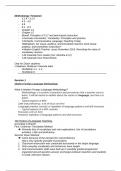Samenvatting
Samenvatting Engels: Vakdidactiek 1.1 Tentamen
- Instelling
- Fontys Hogeschool (Fontys)
Dit document is een samenvatting voor het tentamen voor vakdidactiek 1.1 voor de lerarenopleiding Engels. Het is in 2020 geschreven maar in 2025 nog gebruikt, met een 8,5 als resultaat!
[Meer zien]




